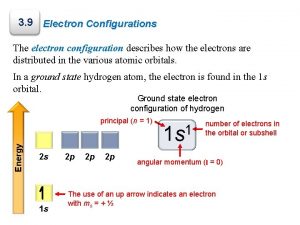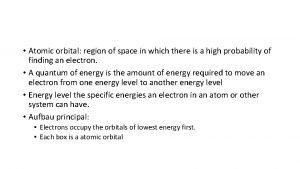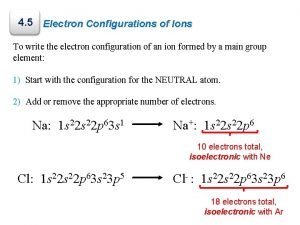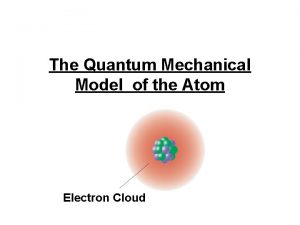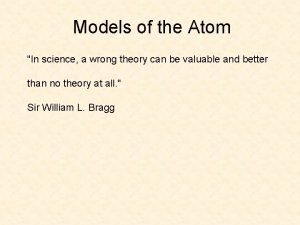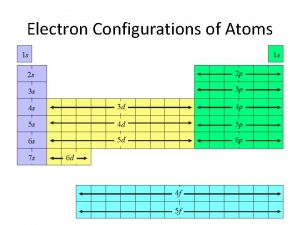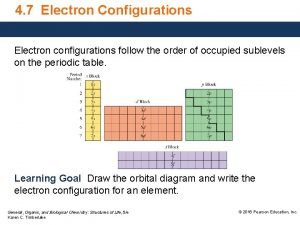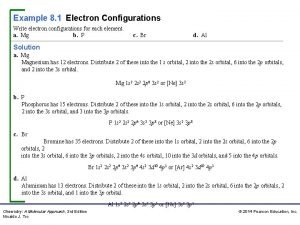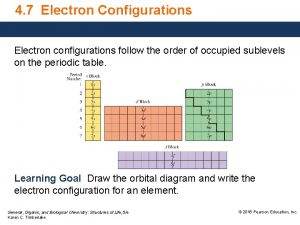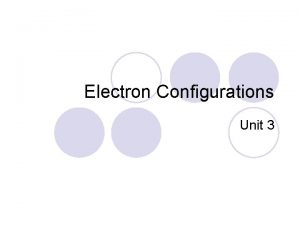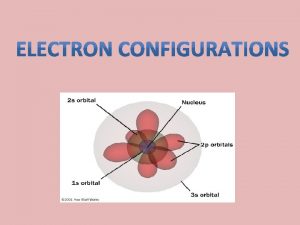Electron Configurations THE QUANTUM MECHANICAL MODEL OF THE

















- Slides: 17

Electron Configurations THE QUANTUM MECHANICAL MODEL OF THE ATOM

Quantum Mechanical Model �Developed by Erwin Schrodinger �aka “Electron Cloud” model �Doesn’t define an exact path of electron; estimates probability of finding electron in a certain location �Uses atomic orbitals = a 3 -D region around nucleus that describes the electron’s probable location. Each orbital can hold a maximum of 2 electrons

The Quantum Mechanical Model of the Atom �The wave function predicts a three-dimensional region around the nucleus called the atomic orbital.

Atomic Orbitals �Electrons cannot exist between energy levels (just like the rungs of a ladder). �Principal quantum number (n) indicates the relative size and energy of atomic orbitals. n specifies the atom’s major energy levels, called the principal energy levels.

Electron Energy Level �Energy levels are broken up into sublevels: �There at least 4 possible types of sublevels—given labels: s, p, d, or f

Sublevels and Orbitals Maximum Number of Electrons In Each Sublevel Number of Orbitals Max. # e- s 1 2 p 3 6 d 5 10 f 7 14

Electron Configurations �The electron configuration of an atom is the arrangement of the electrons around the nucleus of an atom. �RULES: �Aufbau Principle: Electrons are added one at a time to the lowest energy orbitals available until all the electrons of the atom have been accounted for.

Rules Continued �Pauli Exclusion Principle: An orbital can hold a maximum of two electrons. To occupy the same orbital, two electrons must spin in opposite directions. �Hund’s Rule: Electrons occupy equal-energy orbitals so that a maximum number of unpaired electrons results.

Filling Order of Orbitals

Example of Electron Configurations 1. Hydrogen 2. Lithium 3. Carbon

More Examples �Iron: �Sulfur

Valence Electrons �The electrons occupying the outermost energy levels of an atom �Located in the highest occupied s and p sublevel Maximum Number = 8 �Determined by the location of the element on the periodic table. �Determine the physical and chemical properties of the element

Finding # of Valence Electrons �Group #1 = 1 valence electrons �Group #2 = 2 valence electrons �For Groups #13 -18 Subtract 10 from the group # = # valence electrons Exception Helium only has 2

Noble Gas Stability �Noble gases are usually unreactive �This is because they have max. # valence electrons �For two atoms to join together atoms must gain, lose or share electrons �Elements with max. # of valence electrons do not easily gain or lose electrons

Practice Problems �Determine the number of valence electrons for the following elements: Sodium Chlorine Neon Magnesium Aluminum

Electron (Lewis) Dot Diagrams �Model used to display the valence electrons of an element. �Includes the symbol of the element and the valence electrons represented as dots. �Example: Oxygen

Practice Problems �Draw the electron dot diagram for the following elements. �Calcium �Arsenic
 Quantum mechanical model and electron configuration
Quantum mechanical model and electron configuration Quantum mechanical model definition
Quantum mechanical model definition Orbital diagram for ca
Orbital diagram for ca Chapter 8
Chapter 8 Calcium ion formula
Calcium ion formula Chapter 5 electrons in atoms
Chapter 5 electrons in atoms An orbital is a region of space in an atom where there is
An orbital is a region of space in an atom where there is Dot
Dot Stable electronic configuration
Stable electronic configuration Bohr model vs quantum model
Bohr model vs quantum model Quantum mechanical model atom
Quantum mechanical model atom Quantum mechanical atom model
Quantum mechanical atom model Sublevel d
Sublevel d Quantum mechanical model definition
Quantum mechanical model definition Modern quantum mechanical model
Modern quantum mechanical model Atomic emission spectra and the quantum mechanical model
Atomic emission spectra and the quantum mechanical model Quantum mechanical model
Quantum mechanical model Schrodinger atom model
Schrodinger atom model


